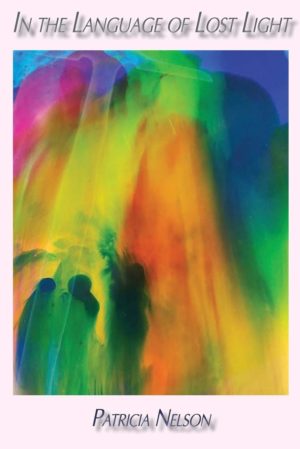In the Language of Lost Light
by Patricia Nelson
reviewed by Susan E. Gunter
In her powerful new poetry collection, In the Language of Lost Light, Patricia Nelson presents a world of shadows, the aftermath of light. Nelson reveals how light both illuminates and obscures reality, how it can be mesmerizing yet deceptive. Her rich, complex poems amply repay reading and rereading.
Nelson works in the Activist tradition, which the poet Lawrence Hart began in the San Francisco Bay Area in the 1930s. As Nelson notes in her afterword, the Activist school emphasizes clusters of metaphors, organizing material through associations rather than narratives. This elliptical method challenges readers, yet it is often startlingly beautiful; when Activist poets link disparate parts of reality, they allow us to see more deeply into that reality. Nelson is among the very best of the contemporary Activist poets, indeed among the best of today’s poets.
In the Language of Lost Light contains four sections, “The Glow of an Edge,” “Camelot,” “Paradiso (after Dante),” and “Between the Worlds.” These sections link thematically through use of “light” and through the poet-narrator’s search for meaning in a dangerous world. In addition to “light,” other words recur: wind, edges, dream, water, color, death, fire, stone, wishes, shine. Nelson employs tight formal verse patterns, as if to contain the darkness lurking below her poems. She uses tercets and quatrains, with occasional couplets and one-line stanzas to conclude poems. Internal rhyme, slant rhyme, and, very rarely, perfect rhyme give her poems a musical quality, a counterpoint to the book’s existential search.
The first section, “The Glow of an Edge,” begins with “Daedalus,” who sought the sun. Nelson’s Daedalus holds “this empty sky,” implying that our life-giving sun has disappeared. The poems proceed through this method of indirection. In “Icarus,” instead of stating that her subject falls back to earth, she sketches “his shadow growing, large again / upon the rock and water, pulling him.” In “Wish,” we have Icarus’s “wish to fly,” and in the subsequent “The Heavy Animals,” flying becomes “a wish to be heard.” Then we move from Greek myth to Shakespeare’s The Tempest, and finally to Hansel and Gretel, with some poems not related to any particular source. The writing in this section is vivid and original. In “Caliban,” we have Caliban’s point of view, as he curses his masters: “They should scuttle in the light, / crawl like fire on a black wick.”
The second section, “Camelot,” is the strongest. Basing her poems on Arthurian legends, Nelson uses concrete abstractions to create a moving narrative of King Arthur, Queen Guinevere, and Sir Launcelot. Arthur’s love for Guinevere has become “a small, bright river where I held everything / in the rushing slenderness of sight.” The poem ends with “bright creatures whirling / toward the cold white sturgeon,” the fish a stunning correlative for Arthur’s sorrow. When Launcelot’s passion for Guinevere strikes him, the “air darkened suddenly”; the sorcerer who predicted her story’s ending has his truths harden “like minerals.” Nelson refers frequently to the artifice of story, yet also makes these legends depict real human failures. The sonnet “Arthur Is Dead” ends by asking, “What did the lost light mean, that spills / black wishes and white ashes?” Nelson wonders again and again: what is this existence that we endure?
In “Language of Lost Light,” from the third section, light breaks when Adam and Eve are expelled from the Garden of Eden; the poet’s job is to restore the light and music of paradise. Nelson meditates on mortality, a world in thrall to time. The poems move away from the Paradiso, their ostensible referent; the last in this section, “When I Return,” comments on the conclusion of Dante’s journey, as he views the world’s objects: gull, fountain, apple, and “odd warm light.”
The final section, “Between the Worlds,” starts with “There Is Something,” inviting readers to explore what lies between worlds. The poet never specifies what these “Worlds” are—those of body and spirit, past and present, real and imagined?–and this lack of specificity allows Nelson to range widely. “There Is Something” suggests Yeats’s “The Second Coming.” Here, “something else” is an animal “once everywhere but now rare.” Her paradise includes “animals with shadows that swing” and “legless animals that slide,” alarming images suggesting that her heaven and hell, unlike Dante’s, are equivalent. Many images are disturbing: a red embryo, a homunculus, a boy the faeries stole, raucous black birds, a mythical massive animal, a giant, and the dead. One of her most beautiful poems, “The Dead,” recalls the Book of Revelations, where Death rides a pale horse. Its final lyrical quatrain hymns the wildness of the earth and our attempts to understand that wildness:
Its gallop strikes the freshness
of this silence like a wild rain,
gusts of brown where colors cannot go,
a listening as deep as sobbing.
The collection’s final poem, “The Garden and the Thorns” begins, fittingly, with light and ends in shadow: “[b]eyond the circle of color and light / is the unkempt dark of fir and thorns.” Nelson reminds us once more of our tenuous existence. Her brilliant, enigmatic voice compels us to examine the outer world and our own depths.
Published on April 12, 2021

